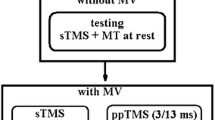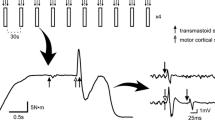Abstract
Cervical responses (SEPs) to stimulation of the median, radial and ulnar nerves were studied in 9 healthy subjects. In recordings from e Cv7 electrode referenced to a scalp electrode P11 presented a bilobed (P11a+P11b) profile for all three nerves whereas from Cv2 only P11b appeared as a rule. P11a and P11b were more distinct in the ulnar than in the median and radial nerves. The P11onset-P13onset interval was virtually the same for the radial and median nerves and approximately 0.4 msec longer for the ulnar nerve. This difference probably represents the Cv8 to Cv6 intramedullary conduction time. An exact evaluation of P11onset is possible only in low cervical recordings, though the P11peak may be a useful landmark when recording from Cv2. P11a would appear to originate at (or near) spinal entry, P11b high in the cervical cord and P13 at supraspinal level.
Sommario
In nove soggetti, sono state studiate le risposte cervicali da stimolazione dei nervi mediano, radiale ed ulnare. Utilizzando un riferimento cefalico, P11 appare bilobata, registrando da Cv7, per tutti e tre i nervi, mentre solo la seconda delle due subcomponenti (P11a e P11b, rispettivamente) viene registrata generalmente da Cv2. P11a e P11b sono meglio distinte fra di loro nel caso del nervo ulnare, che non del radiale o mediano. L'intervallo P11onset-P13onset è sovrapponibile fra mediano e radiale e circa 0.45 msec più lungo per il nervo ulnare; questa differenza dovrebbe essere dovuta ad un tempo di conduzione intramidollare fra Cv8 e Cv6. Una esatta valutazione di P11onset è possibile solo a livello cervicale inferiore, mentre il picco P11b può essere utilizzato nel computo delle latenze solo da Cv2. P11a dovrebbe originare all'ingresso spinale, P11b nel tratto cervicale superiore, P13 a livello sopraspinale.
Similar content being viewed by others
References
D'alpa F.:Conduction time in central somatosensory pathway: an improved technique. Acta Neurologica (Napoli); New series,6, 1984 (in press).
D'alpa F.:Cervical SEPs from musculocutaneous nerve stimulation. Acta Neurologica (Napoli); New Series,6, 1984 (in press).
D'alpa F., Sallemi G., Warth H., Grasso A.:PES sottocorticali (n. mediano). II. Analisi delle componenti a diversi livelli lungo la via lemniscale. Quaderni di Acta Neurologica (Napoli);49, 160–163, 1984.
D'alpa F., Grasso A.:Componenti spinali del PES: confronto fra i nervi mediano ed ulnare. (In preparation), 1984.
D'alpa F., Consoli V., Grasso A., D'aliberti G., Scialfa G.:Subcortical SEPs in upper cervical cord compression. Case report. (In preparation); 1984.
Desmedt J.E., Cheron G.:Central somatosensory conduction in man: neural generators and interpeak latencies of the far-field components recorded from neck and right or left scalp and earlobes. Electroenceph. clin. Neurophysiol.,50, 382–403, 1980.
Desmedt J.E., Cheron G.:Prevertebral (oesophageal) recording of subcortical somatosensory evoked potentials in man: the spinal P13 component and the dual nature of the spinal generators. Electroenceph. clin. Neurophysiol.,52, 257–275, 1981.
Eisen A., Elleker G. Sensory nerve stimulation and evoked cerebral potentials. Neurology,30, 1097–1105, 1980.
Grisolia J.S., Wiederholt W.C.:Short latency somatosensory evoked potentials from radial, median and ulnar nerve stimulation in man. Electroenceph. Clin. Neurophysiol.,50, 375–381, 1980.
La Joie W.J., Melvin J.L.:Somato-sensory evoked potentials elicited from individual cervical dermatomes represented by different fingers. Electromyogr. clin. Neurophysiol.,23, 403–411, 1983.
Mauguiere F.:Les potentiels évoqués somesthésiques cervicaux chez le sujet normal: analyse des aspects obtenus selon la siège de l'électrode de référence. Rev. EEG Neurophysiol.,13, 259–272, 1983.
Siivola J., Myllyla V.V., Sullg I., Hokkanen E.:Brachial plexus and radicular neurography in relation to cortical evoked responses. J. Neurol. Neurosurg. Psychiat.,42, 1151–1158, 1979
Synek V.M.:Somatosensory evoked potential from musculocutaneous nerve in the diagnosis of brachial plexus injuries. J. Neurol. Sci.,61, 443–452, 1983.
Synek V.M., Cowan J.C.:Somatosensory evoked potentials in patients with supraclavicular brachial plexus injuries. Neurology,32, 1347–1352, 1982.
Synek V.M., Cowan J.C.:Somatosensory evoked potentials in patients with metastatic involvement of the brachial plexus. Electromyogr. clin. Neurophysiol.,23, 545–551, 1983.
Yiannikas C., Shahani B.T., Young R.R.:The investigation of traumatic lesions of the brachial plexus by electromyography and short latency somatosensory potentials evoked by stimulation of multiple nerves. J. Neurol. Neurosurg. Psychiat.;46, 1014–1022, 1983.
Author information
Authors and Affiliations
Rights and permissions
About this article
Cite this article
D'Alpa, F. Comparison of cervical SEPs on median, radial and ulnar nerve stimulation. Ital J Neuro Sci 6, 177–183 (1985). https://doi.org/10.1007/BF02229189
Issue Date:
DOI: https://doi.org/10.1007/BF02229189




